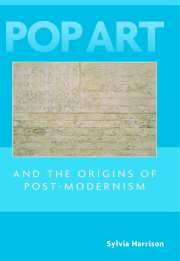Book contents
- Frontmatter
- Contents
- Introduction
- PART ONE THEORETICAL FRAMEWORK
- PART TWO “SOCIAL” CRITICS
- 2 Lawrence Alloway: Pop Art and the “Pop Art-Fine Art Continuum”
- 3 Harold Rosenberg: Pop Art and the “De-definition” of Both Art and “Self”
- 4 Leo Steinberg: Pop, “Post-Modernist” Painting and the Flatbed Picture Plane
- PART THREE “PHILOSOPHICAL” CRITICS
- PART FOUR “CULTURAL” CRITICS
- Conclusion
- Notes
- Index
4 - Leo Steinberg: Pop, “Post-Modernist” Painting and the Flatbed Picture Plane
from PART TWO - “SOCIAL” CRITICS
Published online by Cambridge University Press: 23 July 2009
- Frontmatter
- Contents
- Introduction
- PART ONE THEORETICAL FRAMEWORK
- PART TWO “SOCIAL” CRITICS
- 2 Lawrence Alloway: Pop Art and the “Pop Art-Fine Art Continuum”
- 3 Harold Rosenberg: Pop Art and the “De-definition” of Both Art and “Self”
- 4 Leo Steinberg: Pop, “Post-Modernist” Painting and the Flatbed Picture Plane
- PART THREE “PHILOSOPHICAL” CRITICS
- PART FOUR “CULTURAL” CRITICS
- Conclusion
- Notes
- Index
Summary
Leo Steinberg was born in Moscow in 1920. Formal study included that undertaken in England at the Slade School of Art and the University of London for which he received a diploma (fine arts) in 1940. He arrived in the United States in 1945, the country in which he would henceforth reside and, later, take out citizenship. Further study followed at the Institute of Fine Arts, New York University, for which he was awarded a Ph.D. in 1960. It was not until 1953, the year in which he turned thirty-three, that Steinberg published his inaugural essay on twentieth-century art. Over the following eighteen years, however, he amassed a considerable body of writing on art from this period. This comprised essays and to a lesser extent reviews, the latter being a legacy of his ten-month stint as a reviewer for Arts magazine during part of 1955 and 1956. It was of a size and substance sufficient to warrant publication in 1972 in the form of the anthology entitled Other Criteria: Confrontations with Twentieth-Century Art. In retrospect, Steinberg's writings on both modern and contemporary art were only an adjunct to those produced in his primary vocational role of academic and historian of sixteenth- and seventeenth-century Italian art. They provide, nonetheless, valuable insights into the critical consciousness of the sixties and shortly thereafter, the time span of this study.
- Type
- Chapter
- Information
- Pop Art and the Origins of Post-Modernism , pp. 96 - 112Publisher: Cambridge University PressPrint publication year: 2001



